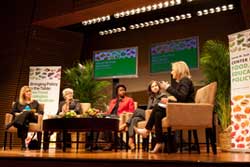Extracting the Proof from the Pudding
A panel of nutrition experts discusses the challenges of basing policy on evidence
“Our mantra is, ‘In God we trust – all others must show data.’”
The line drew laughs, but Susan Kansagra, Assistant Commissioner of the Bureau of Chronic Disease Prevention and Tobacco Control of New York City’s Department of Health and Mental Hygiene, was summing up the central thrust of “How Do We Know What Works?”, a panel discussion among academics and policymakers at TC’s Valentine’s day nutrition conference.
Confirming that a policy-based approach has actually made a difference in the health of an entire population is no simple matter, Kansagra said, because health problems such as obesity and diabetes do not stem from a single cause and are almost never respond to a single “cure.”
“The approaches you’ve heard about today are about policy systems and environmental changes,” Kansagra said, and therefore must be assessed differently than interventions aimed at improving the health of individuals, in which “you look at clinical trials that compare Intervention A to Intervention B.” For example, it’s easy, she said, to compare the health of a person who smokes to that of someone who doesn’t. But evaluating the impact of a smoke-free environment in New York’s bars and restaurants is more complicated, because it’s not possible to expose one group of people to smoky air and while limiting a control group to smoke free environments.
To tease out those kinds of results, whether in connection with smoking or with food and obesity, requires “an accumulation of evidence to determine whether we’re moving in the right direction,” said Noreen Clark, Myron E. Wegman Distinguished University Professor Public Health at the University of Michigan. And that, said Clark, who is a Teachers College alumna, requires surveillance. “We need to track policy and then look in the same populations where policies were modified” to see if there have been broad-scale statistical changes over time, Clark said.
Nicole Harris-Hollingsworth, Senior Director of Community & Population Health at Montefiore Medical Center in the Bronx and President of the New York City Public Health Association, said that to demonstrate such change, “you have to show movement” first in community acceptance of change initiatives and, second, in “consumption variations” – actual targeted changes in health behavior communitywide. Harris-Hollingworth, who also is a TC alumna, looked for precisely these kinds of indicators in assessing New York City’s Green Cart initiative, funded by the Laurie M. Tisch Illumination Fund in 2008, which has sought to bring fresh produce to underserved neighborhoods.
Specifically, Harris-Hollingworth said her organization has been able to determine that people are able to find the Green Cart vendors in their neighborhoods, and that neighborhoods where the vendors operate are consuming more fruits and vegetables. Of course, the initial baseline for comparison was starkly clear.
“You’d be surprised how many people in New York City have never eaten a piece of broccoli,” she said.
While the panel participants all cited the nation’s successful anti-smoking campaign as a model for changing food policies and behaviors, they also noted that some of the challenges relating to food are unique.
With tobacco, “you have a choice not to smoke,” said Jamie Bussel, Program Officer with the Robert Wood Johnson Foundation, but with food that’s obviously not the case. “People have to eat.”
“You have to remember that if someone is choosing between eating health food and paying for housing or medication, you can’t just tell them to choose healthy eating,” said Harris-Hollingsworth. She added that researchers and health officials who want their interventions to succeed need to help people “balance what they perceive as their most pressing needs.”
More broadly, the panelists agreed that researchers must engage communities as full-fledged partners, Harris-Hollingsworth said, both in interventions and in subsequent evaluations. Collaborating with community members on an evaluation design is essential.
Ultimately, while data is important, it is just one tool among many for advancing positive change. Kansagra recalled that members of the New York City Council were duly impressed by the testimony of a leading expert on secondhand smoke – but what really spurred them to pass new legislation, she said, was the story of a pregnant waitress whose job was exposing her daily to smoky air.
“You’ve got to put data in the right context, so that it won’t be perceived differently by different people,” she said.
Published Saturday, Feb. 23, 2013
